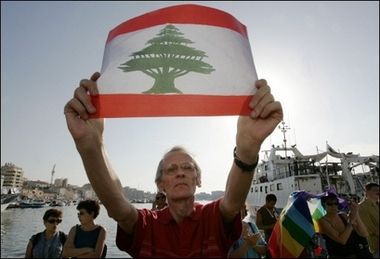 BEIRUT, Lebanon - Israeli warplanes struck a minibus carrying people fleeing the fighting Sunday in southern Lebanon, killing three people, Lebanese security officials said, and two people were killed as about 90 Hezbollah rockets fell on northern Israel.
BEIRUT, Lebanon - Israeli warplanes struck a minibus carrying people fleeing the fighting Sunday in southern Lebanon, killing three people, Lebanese security officials said, and two people were killed as about 90 Hezbollah rockets fell on northern Israel.
Syria, one of Hezbollah's main backers, said it will press for a cease-fire to end the fighting
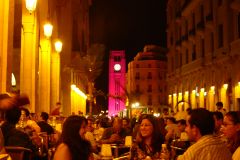 BEIRUT, Lebanon -- Fewer restaurants than usual are open, making the narrow street appear dimmer. A staff shortage has owners tending bar, and the menus have thinned.Still, despite the death and destruction wrought by an Israeli offensive against Hezbollah militants, a small and tenacious coterie of war clientele have clung to Beirut's famed nightlife, hoping for a moment of reprieve from the violence.
BEIRUT, Lebanon -- Fewer restaurants than usual are open, making the narrow street appear dimmer. A staff shortage has owners tending bar, and the menus have thinned.Still, despite the death and destruction wrought by an Israeli offensive against Hezbollah militants, a small and tenacious coterie of war clientele have clung to Beirut's famed nightlife, hoping for a moment of reprieve from the violence.
The fact that the restaurants and bars lining trendy Gouraud Street, a narrow one-way thoroughfare cutting through Beirut's downtown, are still open and drawing clientele is a testimony to the resilience of a city and a country too painfully accustomed to war.Even at the height of the 1975-1990 civil war, Beirut residents braved militia fighting and Israeli bombing to head to the beach for a dip or to cafes and restaurants for an evening meal.While the conflict now is different, the expressions they wear on their faces are eerily reminiscent of those worn by Lebanese during the earlier war.
At one pub along the street, Sana Taweeleh sits next to her young son, Maxim Abi-Aad, at the long wooden bar dominating the tiny room. The outing was a treat for Abi-Aad, who was spending the weekend with his mother. Taweeleh and her husband are divorced."Do I look happy?" asked Abi-Aad from behind a giant glass of a frothy, pink fruit cocktail. "Well, at least this is better than being bored at home."
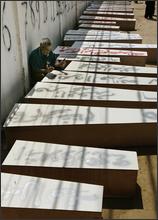 TYRE, Lebanon -- Soldiers laid 72 coffins in two trenches, a mass grave for victims of the Israeli bombardment. Elsewhere, mounds of rubble sat undisturbed; rescue workers were too fearful of missiles to search for bodies.
TYRE, Lebanon -- Soldiers laid 72 coffins in two trenches, a mass grave for victims of the Israeli bombardment. Elsewhere, mounds of rubble sat undisturbed; rescue workers were too fearful of missiles to search for bodies.
Lebanese have streamed out of south Lebanon since fighting erupted between Israel and Hezbollah last week, leaving some villages almost deserted. But many people are believed trapped in their homes - too poor to live anywhere else, too afraid to travel or unable to go because bridges and roads have been destroyed.
An estimated 400,000 Lebanese make their home south of the Litani River, 20 miles from the Israeli border, and it's not known how many remain - but those that do risk being caught up in an Israeli ground offensive against Hezbollah.
"It is not looking good and it's going to last for some time," Ali Sayegh, a 39-year-old furniture salesman from Tyre, said of the Israeli offensive.
"There are not many people left in Tyre, very few walk the streets and there is a shortage of fresh produce," said Sayegh, who moved to a seaside hotel after sending his wife and two daughters abroad last week.
DAY10, AP, 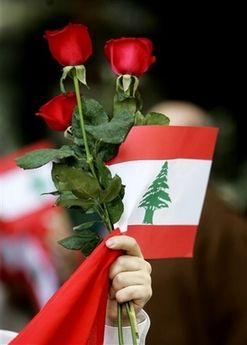 Israel massed tanks and troops on the border Friday hours after calling up reserves and confirmed some units were already operating in Lebanon, as the army announced plans for a ground operation to destroy Hezbollah's tunnels, hideouts and weapons stashes. With Hezbollah's rocket attacks and Israeli bombings undiminished, Secretary of State Condoleezza Rice said she would visit the Middle East beginning Sunday - her first trip to the region since the crisis erupted 10 days ago. But she ruled out a quick cease-fire between Israel and the Shiite guerrillas as a "false promise."
Israel massed tanks and troops on the border Friday hours after calling up reserves and confirmed some units were already operating in Lebanon, as the army announced plans for a ground operation to destroy Hezbollah's tunnels, hideouts and weapons stashes. With Hezbollah's rocket attacks and Israeli bombings undiminished, Secretary of State Condoleezza Rice said she would visit the Middle East beginning Sunday - her first trip to the region since the crisis erupted 10 days ago. But she ruled out a quick cease-fire between Israel and the Shiite guerrillas as a "false promise."
Israel, which pulled its troops out of Lebanon just six years ago after a lengthy and costly occupation that caused painful divisions within the Jewish state, was poised to carry out its third large-scale ground operation in Lebanon since 1978. This time, however, the Israelis signaled they did not want to stay long. Israel hopes the operation will end in the neutralization of Hezbollah. But the operation carries great risks for the country and the region. If Lebanon's weak central government is undermined, it could immerse the country again into disorder and ignite fresh passions in many Arab countries against Israel and the United States. To view more pictures pls click "READ MORE" or to view pictures from previous days pls click "news archive"
Khazen History


Historical Feature:
Churches and Monasteries of the Khazen family
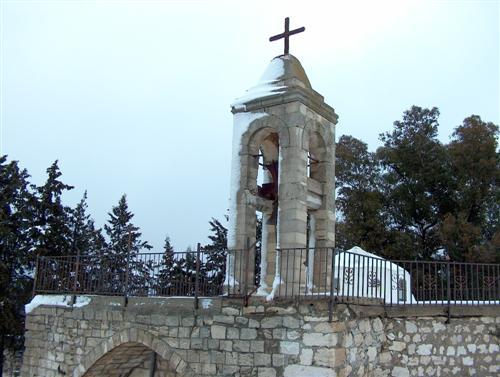
St. Anthony of Padua Church in Ballouneh
Mar Abda Church in Bakaatit Kanaan
Saint Michael Church in Bkaatouta
Saint Therese Church in Qolayaat
Saint Simeon Stylites (مار سمعان العامودي) Church In Ajaltoun
Virgin Mary Church (سيدة المعونات) in Sheilé
Assumption of Mary Church in Ballouneh
1 - The sword of the Maronite Prince
2 - LES KHAZEN CONSULS DE FRANCE
3 - LES MARONITES & LES KHAZEN
4 - LES MAAN & LES KHAZEN
5 - ORIGINE DE LA FAMILLE
Population Movements to Keserwan - The Khazens and The Maans
ما جاء عن الثورة في المقاطعة الكسروانية
ثورة أهالي كسروان على المشايخ الخوازنة وأسبابها
Origins of the "Prince of Maronite" Title
Growing diversity: the Khazin sheiks and the clergy in the first decades of the 18th century
Historical Members:
Barbar Beik El Khazen [English]
Patriach Toubia Kaiss El Khazen(Biography & Life Part1 Part2) (Arabic)
Patriach Youssef Dargham El Khazen (Cont'd)
Cheikh Bishara Jafal El Khazen
Patriarch Youssef Raji El Khazen
The Martyrs Cheikh Philippe & Cheikh Farid El Khazen
Cheikh Nawfal El Khazen (Consul De France)
Cheikh Hossun El Khazen (Consul De France)
Cheikh Abou-Nawfal El Khazen (Consul De France)
Cheikh Francis Abee Nader & his son Yousef
Cheikh Abou-Kanso El Khazen (Consul De France)
Cheikh Abou Nader El Khazen
Cheikh Chafic El Khazen
Cheikh Keserwan El Khazen
Cheikh Serhal El Khazen [English]
Cheikh Rafiq El Khazen [English]
Cheikh Hanna El Khazen
Cheikha Arzi El Khazen
Marie El Khazen